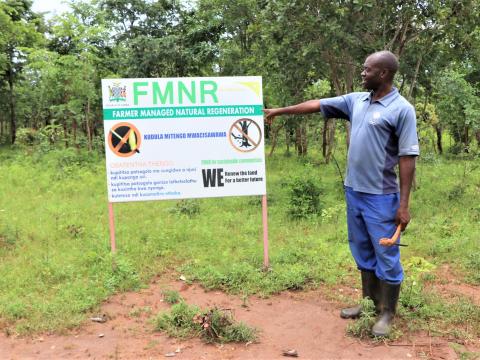'Trees are our lifeline’

By Kambani Phiri, Communications, Zambia
“If not for World Vision’s FMNR training through THRIVE, our land would have been without any trees, and we would be languishing in poverty with our children having no future,” says 46-year-old Adamson Zulu, an FNMR beneficiary.
Deforestation is a problem in many African countries, particularly in Zambia. Deforestation is affecting Africa at twice the world rate. According to the University of Pennsylvania African Studies Center, 31 per cent of Africa’s pastures and 19 per cent of its forests are classified as “degraded.”
According to the National Strategy to reduce deforestation and forest degradation, Zambia has an estimated deforestation rate of 250,000 to 300,000 hectares per year. Drivers of deforestation range from wood fuel, agriculture expansion, mining, and timber extraction, bush fires to land and infrastructure development. Many people, especially in rural communities, depend on the forests for their livelihood and survival.
To cushion the impact of deforestation and promote trees’ replanting, World Vision through Transformed Household Resilience in Vulnerable Environments (THRIVE) is implementing the Farmer Managed Natural Regeneration model (FMNR) in seven Area Programmes in Zambia. FMNR is a rapid, low cost and easily replicated approach to restoring and improving agricultural, forested, and pasture lands. It is based on encouraging the systematic regrowth of existing trees or self-sown seeds. It can be used wherever there are living tree stumps with the ability to coppice (re-sprout) or seeds in the soil that can germinate.
FMNR gives individuals and communities responsibility for the care and nurture of naturally occurring woody vegetation and rewards from the sustainable harvesting of wood and non-timber forest products.
Adamson Zulu, a trainer of trainers and chairperson of FMNR committee in Kalumbila community, Katete district, says the model has helped his community restore forestry as almost all trees were cut for charcoal and farming.
“Previously, before THRIVE, we used to cut down trees for charcoal; as a result, almost all the land was plain. We had many problems due to the lack of trees, but the major challenge was the erratic rainfall pattern. We experienced droughts in the 2016/2017 farming season, which led to many families having no food. When THRIVE came in 2016, they trained us on the importance of keeping trees. In 2018 we started maintaining 12.5 hectares of forestry. Today the forest is our livelihood; this year 2020/2021 farming season, we are receiving increased amount of rains,” says Mr. Zulu. “If someone is found cutting down trees, we charge them K500 (US$ 23), and if he or she fails to pay, the committee reports the person to the traditional leader who decides further punishment for the individual.”
And Headman Josias of Mbang’ombe Chiefdom excitedly said there is a newly found source of income in the forest. “Through these forests, we are able to take our children to school, build housing infrastructures and also it is our source of food and medicines. The biggest benefit of all is that the village makes money out of the trees by harvesting honey. This has given families a source of income through the selling of honey. For this reason, community members value the importance of having trees in the community and protect the forest because they know that their lives depend on it.”
The traditional leader further explained that the village would continue to expand the forest, so the future generation benefit.
“We invited everyone in the community, young people, men, and women, and trained them on the importance of taking care of the trees. We further took them to the small forest to show them how to prune properly without damaging the trees. So far, we have seen great progress as we have reserved three forests, each about four hectares, and everyone is on board to maintain and protect trees. We are slowly restoring nature; the trees have created a habitat to enable wildlife and birds to return.” says Headman Josias. “I would like to thank World Vision for taking time to train us on the importance of trees, and my community is developing because of this very forest.”
Fifty-year-old Saiti Phiri, a beneficiary of FMNR training, says he doubted the lessons when first approached to be trained. “When the headman approached me to be a participant in the FMNR training, I was very skeptical, and I only attended the training because of the traditional leader. Today, I am a key advocate of FMNR because I have witnessed the benefits. Previously, our crops, especially maize, used to be swept by the strong winds as there were no windshields. Treeless landscapes have been restored through FMNR. I planted some trees in my fields to act as windshields and prevent soil erosion. I thank World Vision for coming to the village. They have given us new hope and life.”
And THRIVE Project Manager Moffat Mtonga said FMNR has improved food security and cushioned climate change impact for the local farmers.
“From the interactions and field inspections, it is evident that the introduction of FMNR along with other models like Farming God’s Way and Empowered WorldView practices has proven to improve food security and resilience for smallholder farmers and their families. This integrated approach contributes to diversified food options, improved access to food and nutrition, increased crop yields, and improved livestock production. Regenerating trees on cropland promotes increased crop growth during the dry season by providing shade and reducing water evaporation. Trees further provide a buffer against climatic extremes that directly affect crop yields, such as air and soil temperature,” says Mr. Mtonga.